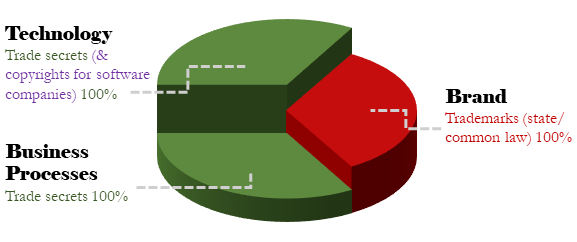If your business has no IP, you are replaceable. By any of your competitors.
How much of your potential patent, trademark, copyright, and trade secret rights (the 4 main categories of IP) have you realized? This article is the definitive visual guide for understanding IP and your tech company. It provides a strategic roadmap for developing your business’s IP portfolio as it grows from a startup to a small or medium enterprise (SME).
There are three functional areas of protection that IP can provide for any company: A.) technology; B.) brand; and C.) business processes. These three functional areas could not be more different from each other; the only common thread is that they are all intangible.
For simplicity, this guide assumes that each functional area captures an equal one-third (1/3) of your company’s overall IP value throughout. The below series of pie charts depict how the balance of the categories of IP that comprise each will change with your company’s growth.
Startups with no federal IP applications

Your IP portfolio’s value has three functional components...,
Trade Secrets
For Protecting Business Processes IP
Trade secret protections are essential for every business. Everyday business processes, including policies and procedures and customer lists, are only protectable as trade secrets.
Trade secrets are vulnerable to misappropriation. The primary risk is your former employees who leave to join your competitors or form their own competing businesses. Once your trade secret is out, it is likely lost for good. The courts can potentially compensate you with monetary damages for trade secret misappropriation, but only after the fact. They cannot unring the bell.
The quality of your employment agreements and your company policies is paramount for protecting your trade secrets. These are critical components of your business processes. And they are almost entirely within your control, in particular as a startup (so let’s get it right from the start — click here).
For Protecting Technology IP
Businesses with no patents or pending patent applications rely 100% on trade secrets to protect any technological innovations they have developed that give them a competitive advantage.
Trade secret protection can be the way to go for certain technologies, in particular those that cannot be reverse engineered. Unlike patents, there is no costly application or registration process for trade secrets. Nor are there any public disclosure requirements. To the contrary, the owner must take reasonable measures to keep trade secrets, well, secret.
But if your underlying technology can be revealed by examining or taking apart your product, then it is simply not protectable as a trade secret. The only way to prevent others from using such technologies is to secure patent protection.
Copyrights (for software companies)
Software—which comprises much if not all of any artificial intelligence (AI)—presents a special case for IP. Most of the technology IP value of any software company is captured in its software,1 specifically its source code. Source code is somewhat confusingly protected by copyright law (which more prominently and intuitively protects original, creative works of authorship, such as publications and art — click here).
Software source code operates in effect as a trade secret. Companies can license their software to end users without significant concern of losing their source code, because it is practically impossible to reverse engineer the source code (and they can prohibit any attempts to do so as part of their license terms).
This guide folds software copyrights under the broader category of trade secrets throughout, for ease of this presentation focused on tech companies.
Common Law and State Trademarks
A trademark is a design, symbol, word or phrase that identifies the source of your products and service. It distinguishes your products and services from those of other companies.
To develop and protect their brand, companies that have not filed for federal trademark protections rely entirely on:
- common law trademarks, which automatically come into effect when you use your company/product/service names in commerce, or
- state trademarks, for which you have to file an application with your secretary of state. State trademarks are inexpensive and easy to obtain relative to federal trademarks.
Common law and state trademarks can only be enforced in state court and in the geographic area you do business in or in your home state respectively.
Startups with pending federal IP applications

…and the IP balance of each component will change as your business grows. …
Federal Trademarks (pending)
About 50% of federal trademark applications filed with the U.S. Patent and Trademark Office (USPTO) are successful. The process typically takes 12-18 months total.
Federal trademarks are stronger than common law or state trademarks. Federal trademarks provide the exclusive right to use them nationwide (within the class of goods or services identified in your registration — click here). They are enforceable in the federal courts.
When your federal trademark issues, you can now mark your goods or services with a registered trademark symbol (®) and the USPTO lists your trademark in its database. This deters others, in particular your competitors or any counterfeiters, from using your mark.
In contrast, while your federal trademark applications are still pending, you can only use the ™ symbol to mark your goods (or the lesser-used ℠ symbol for services). This is the same mark available for pending state trademark applications.
Unlike patents and copyrights, trademarks do not expire after a set period of time. Trademarks are generally good for as long as the owner continues to use them.
Patents (pending)
Unlike trade secrets and trademarks, patents are exclusively an instrument of federal law. Patents can only be issued by the USPTO and are only enforceable in the federal courts.
About 50% of patent applications filed with the USPTO are successful. It typically takes over 18 months from filing before the USPTO provides an initial response. You can expect the entire process to take a minimum of 2-3 years.
Applying for a patent does double duty for the value of your IP portfolio. Not only do patents boost the value of your technology IP, they also increase the value of your company brand.2
Patents generally expire 20 years after the filing date of their first application.
Federal IP rights are more valuable
Filing for patent and federal trademark applications automatically boosts the overall value of your IP portfolio. By properly marking your products and services, you put the public on notice of your pending exclusive, nationwide IP rights. And any potential acquirors of your business will notice—in particular if you don’t have any.
SMEs with issued patents not asserted in court

… Is your business’s IP portfolio on track? …
Patent(s) (issued)
As your business grows into a small-medium enterprise (SME), the investment you made in your patent portfolio should start paying dividends on multiple fronts.
With the USPTO granting at least some of your patent applications, you can now:
- license your patented technology (if you can find willing licensees, i.e. companies willing to pay for it), and
- file a patent infringement suit to exclude other companies from using your patented technology and to seek damages for past infringement.
The value of your brand increases as well, starting with your “patents granted” press release. For tech companies in particular, your business’s reputation for innovation takes off from here.
Federal Trademarks (issued)
After the USPTO grants at least some of your trademark applications, the value of your trademarks and your overall brand IP increase. Federal trademarks trump common law and state trademarks in most every respect. Once a federal trademark issues, it makes obsolete its common law and state equivalents.
SMEs with issued patents asserted in court

… Have you filed your patent and trademark applications? …
Patent(s) (asserted)
Patents are a “negative right.” When issued, you do not gain any affirmative right to do anything you not do before. You only gain the right to exclude others from using your patents. Most notably you can exclude your competitors from using your patented technology in their own products and services.
Patents have some inherent value for purely defensive purposes. Just having a patent portfolio might deter some competitors from asserting their own patents against you (IP’s version of mutually-assured destruction). And they can provide an important negotiating chip should a competitor sue you for infringement of its patents.
But the market may not be moved by your patent portfolio until you start sending out patent license demand letters. And the market, in particular your competitors, will really take notice when you file your first patent infringement suit in federal court.
SMEs with issued patents asserted in and upheld by the courts

…Do you have an effective confidential information and trade secret protection policy in place?
Patent(s) (upheld by the courts)
The value of your patents is not fully realized until you secure an infringement award in federal court.
A final judgment (i.e., one made after exhausting all available appeals) upholding the validity of your patents is ideal but takes years of litigation. A favorable settlement after these issues were substantively litigated can serve nearly as well. Either way, your licensing royalty rate and thus the value of your patents, become far more established in the market. Litigation- and market-tested patents have a way of making prospective licensees far more “willing” to pay for them.
A favorable litigation outcome further increases the value of your brand. It tells the market that you have strong IP rights and you are willing and able to enforce and exclude others from using them.
Come back next Monday at 1 PM PT for the sequel:
“…and without implementing artificial intelligence (AI) successfully, you will be replaced.”
- Software IP value for AI companies, etc. can also—at least in theory—be captured in patents. But that’s a can of worms for another post…. ↩︎
- More accurately stated, any increase in technology IP value—not just from patents, but also from trade secrets or copyrights—also boosts the business’s trademark/brand IP value as well. This is particularly true for any technology company. But it is helpful and easier for us to focus on the impact of patents, from issuance to assertion to upholding by the courts, from here on out. ↩︎




One response to “Without intellectual property (IP), you are replaceable….”
[…] up on last week’s blog (“Without IP, you are replaceable….”), this article first provides a comprehensive overview of the intellectual property (IP) issues […]